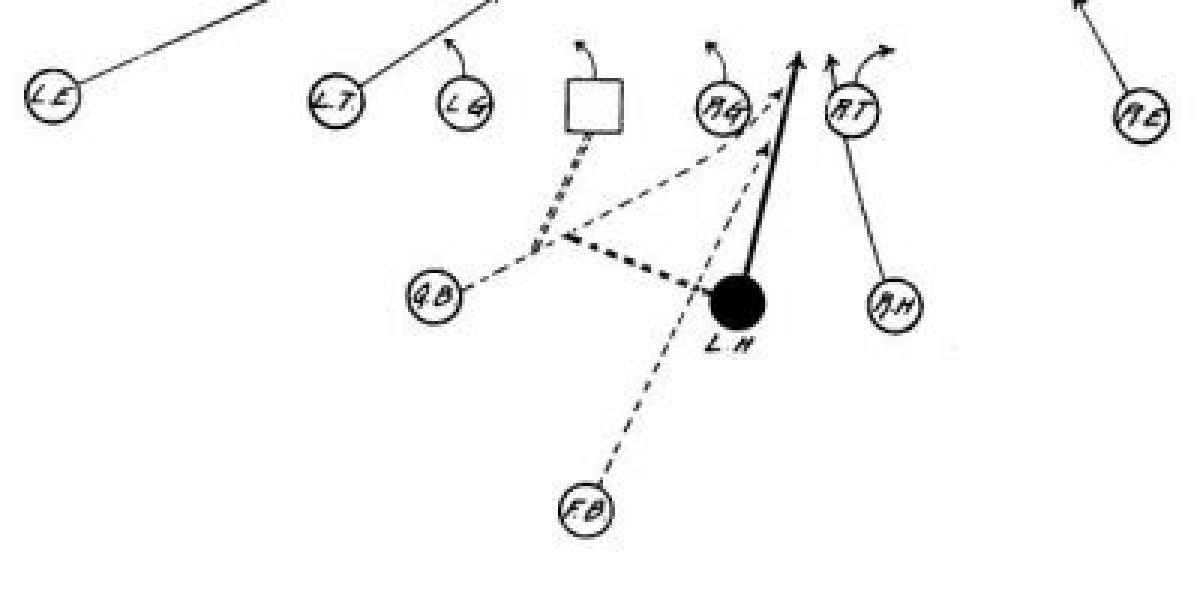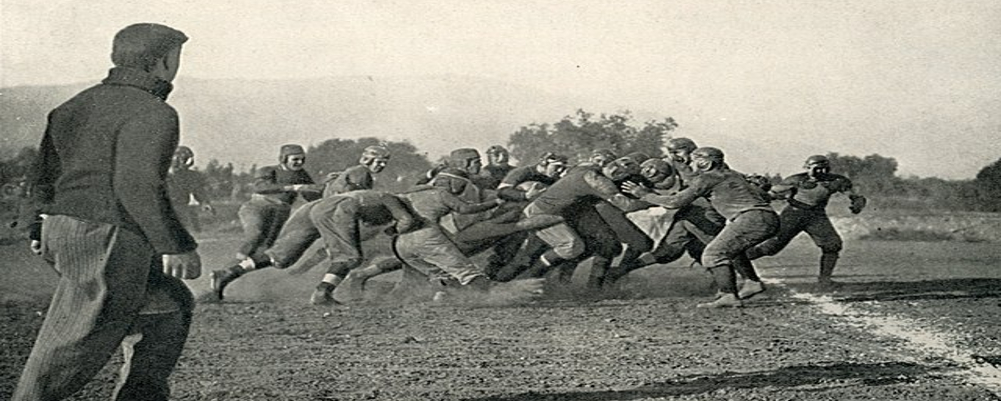Hello, my football friends, Darin Hayes and PigskinDispatch.com. It is Tuesday, and once again, we are going to visit with Timothy P. Brown of FootballArcheology.com. Tim, welcome back to the Pig Pen.
Hey, Darin. Thank you.
Look forward to chatting again. I think we've got a good one to cover this evening. Yeah, this one is a subject that I know a little bit about.
I've talked to an author that's wrote quite a bit about this famous coach, Fielding Yost of Michigan. This is probably his most famous stance or most famous position. That's where the school he's most associated with.
Let me try to get that out of my mouth. But you have a very interesting story on him that sort of takes back through his whole career and sort of settles a dispute by digging through the old newspapers and everything. It's a really interesting, great job of work on your part.
I will let you take it from here, sir. Yeah, thank you. This is one that you're kind of digging around for playing detective, reading old newspapers.
All of a sudden, you find something that I wasn't expecting, quite the ending to the story. This is one of these ideas or issues where everybody talks about football. There's nothing new, right? There's nothing new in football.
Everything gets recycled. Everything gets adapted. That's, at some level, reasonably true.
There are certain true innovations, and one of those is embedded here. It's also a bunch of these people copying ideas over and over again. Part of the funny thing about this story is that there's an instance where things got copied, and this sports writer didn't know that.
Apparently, it was the first time he saw this occur in a game. What it was is that I came across an article from a 1913 game when Michigan played Penn. During the game, Michigan attempted a fake field goal.
This writer just wrote a follow-up after the game about this fake field goal attempt and praising Fielding Yost, talking about what a great innovator he is and blah, blah, blah. When I came across that, I was like, is that possibly the first time somebody ran a fake field goal? I would have thought, even just due to a bad snap or whatever, somebody would have tried one. Then maybe said, geez, this works pretty well.
I'm going to do this again. I'm going to back up just a little bit and say that until 1886, every field goal attempt was a dropkick. There was no snap from the center to a holder who held the ball for the kicker.
It took some human beings to figure out how to do that. It turned out it was these two brothers who played at Otterbein in Ohio, a small school there. They figured out, hey, we could snap the ball, have a guy hold it, and the kicker could kick it.
We've got a better chance, especially under the right weather conditions, a place kick typically had more power and was more accurate than a drop kick because the ball didn't bounce true off the uneven turf and grass at the time. We moved ahead then to 1913 and this Penn-Michigan game. Michigan sets up for a regular field goal attempt.
They snapped the ball, but instead of the holder putting the ball down on the ground, the kicker moved forward and swung his leg forward just like normal, but the holder stood up and then went sprinting around the left end. He scored a touchdown rather than the field goal attempt. Part of what's funny about that is that the writers said, this is tremendous.
The execution of this play was incredible. In fact, the play got called back due to holding, so the execution wasn't that great. Then it was like, here was a fake field goal, obviously a planned fake field goal.
I started looking around, when did these things first occur? As I said earlier, 1886 was the first time that any team snapped to a holder and then executed a placement kick. The first fake field goal that I could find, and this is just through searching newspaper articles, was an 1897 game between Kansas and Iowa when Kansas faked a field goal. Then, the next year, the second one I found is 1898, when Nebraska ran a fake field goal against Kansas.
The guys who did it, as far as I can tell, invented it, and have it executed against them the following year. Then the key thing about that, or the interesting thing about that, is that the coach of Nebraska in 1898 was Fielding Yost, a coach at Michigan whom this writer was just effusive with praise about. So anyway, after doing additional searching and everything, there were fake field goals all over the place.
I'm not saying there were thousands a year or anything like that, but most years, once the placement kick from scrimmage got started, people were also executing the fake field goals. Unfortunately, the writer was an anonymous column, so I couldn't figure out who the writer was that came up with this because otherwise, I would have tried to reach his relatives and tell them that their grandpa was lacking in his football history skills. Okay, so Kansas did it first, and then they had it done against them the following year by Nebraska.
That's correct. Fielding Yost was the coach at Nebraska, and then he was coach again at Michigan when they did this in 1913. Well, I was trying to think about it, because I know from a previous author I had on the biography on Yost, I know he was in Kansas too, but I'm looking right now, he was in Nebraska 1898, he was at Kansas 1899, so it was reverse, where I was thinking he might have been a coach for both of those games, head coach who did it, but he was Kansas on the other side.
And then he ended up, he was at Stanford, right? In 1900? Yeah, Stanford, and then at the end of the season, San Jose State, he did a championship game and then went to Michigan. Pretty well-traveled coach. Yeah, for a little bit there.
And he was Ohio Wesleyan before all of that too. And he was a ringer when he played in college too. Yeah.
He went to West Virginia, but he played for Lafayette in the big game where they took down Penn and snapped their win streak, whatever it was, 2018. Yeah, Park H. Davis, the famous historian, was the coach of Lafayette. So yeah, there's a lot of historic ties there.
Which is why he names that team the National Champs. Yeah, he named a lot of odd ones, National Champs. You can go back and scratch your head a few times.
Yeah, that's a really, really cool story. I love how that sort of circles back around to him, you know. And what was there, 20, almost 20 years in between, 15 years in between the plays.
But I guess the credit is due to him in some respects. Yeah, well, hey, you know, he picked up something, he saw something he liked and executed it. Yeah, plus I think there was, I don't have my note here on it, but I'm almost positive Michigan ran a fake field goal too before the 1913 game, so under Gilst.
Yeah. You know, it brings back that fake field goal. And I'm sure it wasn't a rule at the time.
I'm sure it was a rule put in afterwards. But there was a rule in high school, and I think it was at the collegiate level too, that if somebody, you know how a holder was usually down on a knee to take the snap. That's the only exception where you can have a live ball with a person with their knee on the ground.
So with that exception, they have to hold for a kick or an attempted kick. So if that holder is on a knee, takes that snap, and stands up and throws a pass or runs, it's a dead ball because he was a runner with his knee on the ground with a live ball. So I'm sure, like I said, it probably wasn't back in that era.
They probably put it in. So we had a game, a high school game, where a very clever coach told us before the game, you know, usually they want to make sure we don't kill their brainstorm idea that they had all overnight or something. This guy would get down in a catcher's position.
So both knees are off the ground. He's just in a squat. And the defense, you know, is probably not paying attention to what he's doing, but he would catch the ball.
The kicker would come up similar to what you're saying, fake a kick. This kid would, the holder would pound the ball with his hand. So it sounded like there was a foot hitting the ball and then taking off.
And I think he was going to throw a pass is what his intent was. So, you know, just some clever things that they do out of these, these fake field goals, but that knee-on-the-ground exception. Well, you know, back then, both in the 1898 and the 1913 example, having a knee on the ground, wasn't yet a rule that made the ball dead.
Right. I mean, in that race, you could be tackled and still get up and run. You know, you had to be held to the ground still, but yeah, you know, the, the, the, the catcher squat that you mentioned, that was actually some of the early field goal teams did that.
I mean, those, those executing a placement kick, they did that instead of, of going to the knee. And part of that was because that was still in the time when they, when a lot of teams, still were rolling the ball sideways back from the center to the quarterback. Right.
And so the quarterback, if he was on one knee, he couldn't, you know, the ball would bounce crazily. And so, you know, the squat helped them just, you know, catch the ball properly, or at least be able to reach the ball. And I've even, I've got a picture of Arizona.
And I want to say it was like 1938 or 1936, something like that, where their, their holder is in that kind of squat position. So people continue doing that for, you know, for some time. And probably, you know, they may have just been in a situation where, you know, who knows? It might've had a substitute center, or somebody just wasn't a very, very effective long-snapper.
And so. He was a substitute center. He was also a starting catcher on the baseball team in the spring.
Yeah. Great stuff. That's very fascinating.
Just like every evening, you have these great little pieces and nuggets of information about football history that you don't hear mainstream. And you don't see in every football history book you read in, you know, just like tonight, you took, it took some digging for you to do that. I'm sure, you know, it took a few hours of research going through the old newspapers.
I can feel your pain on that sometime, but it's fun. Yeah. The problem is that, you know, half the time I'm doing these things while I'm watching some football games.
So I don't even watch half the game. I'm just looking online where those 30 points come from. Yeah.
Yeah. Good stuff as always. Why won't you share with the listeners that they, too, can enjoy your tidbits each and every night? Yeah.
So, you know, my website is footballarchaeology.com. So you can go on there. You know, every post allows you to subscribe, which then means you will get an email every night, you know, into your inbox with the story. You can also follow me on Twitter at football archaeology.
And so whichever one works for you, whichever way you prefer to consume information, have at it, or hey, you can do both. So either way. Yeah, I do.
And you get double the pleasure. You get the, the Twitter and the email. So good stuff as always.
Tim, we appreciate you sharing this with us, as well as the great research you do at footballarchaeology.com, your daily tidbits, and, you know, your great writings. Thank you very much for sharing with us each and every week. We hope to talk to you again next Tuesday.
Very good. Always enjoy it. And glad to, glad to spread the word with you on football history stuff.
Transcribed by TurboScribe.ai.




